The Cornell Lab Bird Academy › Discussion Groups › Nature Journaling and Field Sketching › Noticing Themes in Nature
-
I'm observing the cicadas buzzing not only cycles as a group, but increases in intensity around early evening. Also, as of the last week, the intensity of their droning has waned. A possible explanation of the buzzing could be: is it to signal a food source? is it to signal for a mate? The lessening intensity perhaps is indicating the mating season is over, the life cycle of the cicadas is coming to an end and their eggs are laid for the next cycle? The more I observe, the more I marvel at the body of knowledge that has been gained from those who've gone before me and made the observations we have now that encompass the field of biology. It also causes me to appreciate those who didn't have technology at their fingertips and had to gain knowledge of their world by observing the patterns and seasons for their very survival.
-
 Mushrooms growing in the middle of an oak tree. Themes: Scale & Quantity, Patterns, Changes.
Mushrooms growing in the middle of an oak tree. Themes: Scale & Quantity, Patterns, Changes. -
 I wander how grass and plants stay green under several centimetres of snow and ice in winter. Perhaps they have some mecanism of adaption, as birds do, but I do not know. I noticed some tiny birds stay here in winter, and their tiny feet in the ice and snow seem not to bother them.
I wander how grass and plants stay green under several centimetres of snow and ice in winter. Perhaps they have some mecanism of adaption, as birds do, but I do not know. I noticed some tiny birds stay here in winter, and their tiny feet in the ice and snow seem not to bother them.
-
Many themes, it was a challenge to decide which to work on first.


-
May, I like your page and your watercolor of the plant. I especially appreciated your very first note about it's a beautiful little plant.
-
-
There is so much to wonder about and enjoy in our world. I am inspired by the other course attendees! Please keep sharing your journals and thoughts.



-
Listening to the cicadas I was struck with how the rise and fall of the intensity/loudness seemed synchronized among the cicadas in my maple tree. Why and how do they do that? I have learned much about cicadas, but haven't answered that question yet. Still working on it.

-
Finches like to visit our feeder when it is full, but it’s always a flurry of feathers when it begins to run low, and other kinds of birds seem to visit more often when the feeder is less full. - is it that it takes them a while to remember about this easy food source? - do the other birds not want the food when the feeder is full due to the timing? - is it harder for the other birds to get on the feeder with all the finches on it? - do they want to stock up while the food is there so they won’t need it until the feeder runs low again? - all of the above?

-
This was an easy lesson for me. Often when we are traveling or hiking my husband and I will work through the process you have described here. It comes naturally to us. I created the entry below from an observation we made just the other day.

-
I always thought that the dew trapped in spiderwebs was just beautiful, I loved taking pictures of the fantastic "pearls" shining early morning. One day, as I was visiting my home Country Colombia, I started climbing a mountain with my camera looking for birds, but the amazing flora captivated me so much, the sun was rising and all the plants were covered with tiny water droplets. A few hours later, as I was heading down, it was really hot and I was so surprised to to see that even though the plants were dried, some of the spiderwebs were still completely cover with water drops, as they were at dawn.
- Perhaps silk refrigerates water and protect it from evaporation so the spider has fresh water to drink
- Maybe spiders attract insects with water in hot weather
- Water trapped in the silk takes longer to evaporate.



-
These are really beautiful (photos and drawings)!
-
I really like the way you drew and painted the water droplets. I would think that would be hard. How did you do it? If you don't mind my asking?
-
 A fallen tree with beautiful patterns and shadows as decomposition starts. Are insects making these patterns or is it just water prompted rotting?
A fallen tree with beautiful patterns and shadows as decomposition starts. Are insects making these patterns or is it just water prompted rotting? -
Flowers on shrubs attract certain insects; for example, butterflies & bees. Flowers turn into berries and the birds feed on the berries. A garden lizard (Anole) flashes his bright red gizzard to ward off other males. He is protecting his territory. Common Gallinules protect their young by keeping them close by and if they wander off the adults are always aware of their location. They show them how to find food. The young watch and learn from the adults.
-
I got to watch this little mallard family at a lake not far from my house. Although I often see mallards there I think this was the first family sighting. The ducklings stayed so tightly clustered together that they were impossible to count. I would think they stay so close for safety. I also started to wonder if staying directly behind the mama also helps cut the current making easier for them to swim (they were swimming under the dam against the current which can get pretty strong at times, I've seen a small turtle get swept away). Ps. If this posts twice I apologize, I tried posting and it read error so I re posted.

-
Love this!
-
Amazing!
-
I really like your drawing and your lovely description of the ducklings. Thanks.
-
-
 I went to observe the sand crabs - tinny creatures that will disappear with the any movement around it. So, you have to stay still for a bit more than 5 minutes for them to comeback and continue their pieces of art on the sand.
They appear when the tide is low. They are at the lowest level of the ecosystems, shore birds would eat them (I don’t know if the fishes does too but this makes me wonder where do they go when to seawater covers this area of the beach).
The create clean pretty forms in the ground with the beach sand. I was able to video several scenes while they are sucking the sand into their lower body whole then bubbling it out of their mouth creating mini-sand balls. They try to rearrange the sandballs by fixing them in lines with their back legs (Am I using the right word here?).
I went to observe the sand crabs - tinny creatures that will disappear with the any movement around it. So, you have to stay still for a bit more than 5 minutes for them to comeback and continue their pieces of art on the sand.
They appear when the tide is low. They are at the lowest level of the ecosystems, shore birds would eat them (I don’t know if the fishes does too but this makes me wonder where do they go when to seawater covers this area of the beach).
The create clean pretty forms in the ground with the beach sand. I was able to video several scenes while they are sucking the sand into their lower body whole then bubbling it out of their mouth creating mini-sand balls. They try to rearrange the sandballs by fixing them in lines with their back legs (Am I using the right word here?).
 The upper part of the page has a wide scene of the beach; the sand balls looks amazing in reality. The lower part of the page has a close-up of one of the holes , the sand balls, the prints of the sand bubbler crab and the crab (owner of this in process piece of art).
While observing, sketching and videographing, lots of unanswered questions popped into my mind. Some of which are:
1) do they “see” with their eyes or do they sense the vibrations of any movement with their whole body? (They are too fast)
2) why do they form such shapes? Does the bubbled sand-balls has some liquid or smell that comes out of them while bubbling it?
3) is this an indicator of the crab’s territory? Or a mating sign?
4) what is the lifespan of the crab ? At which age(?) do they start designing these bubbled sand ?
5) when the tide is high, and when all their sand-balls are ruins where do they go ? Why do they insist on bubbling new sand-balls over and over and never give up?
6) if they can be pray of birds - doesn’t these sand-balls are clear marks of their existence ? (Bird-view wise they can be spotted easily!)
Guess I have to research it to find answers :)
The upper part of the page has a wide scene of the beach; the sand balls looks amazing in reality. The lower part of the page has a close-up of one of the holes , the sand balls, the prints of the sand bubbler crab and the crab (owner of this in process piece of art).
While observing, sketching and videographing, lots of unanswered questions popped into my mind. Some of which are:
1) do they “see” with their eyes or do they sense the vibrations of any movement with their whole body? (They are too fast)
2) why do they form such shapes? Does the bubbled sand-balls has some liquid or smell that comes out of them while bubbling it?
3) is this an indicator of the crab’s territory? Or a mating sign?
4) what is the lifespan of the crab ? At which age(?) do they start designing these bubbled sand ?
5) when the tide is high, and when all their sand-balls are ruins where do they go ? Why do they insist on bubbling new sand-balls over and over and never give up?
6) if they can be pray of birds - doesn’t these sand-balls are clear marks of their existence ? (Bird-view wise they can be spotted easily!)
Guess I have to research it to find answers :) -
I don't understand the whole sand ball work of the crab either. I spent a day watching the crabs and birds at Pea Island last spring. Your drawings make me want to do some research. Thank you.
-
-
 I have a big patch of Siberian Iris in my backyard that is currently showing all phases of its reproductive cycle, and showing the life cycle change the flower is going through including the seedhead that is formed after pollination. The seedheads in my garden are from last year's flowers that were never deadheaded. Siberian Iris reproduce by seed and by their rhizomes spreading. The Anther is hidden under the Style arms and above the Fall (the lower petal). You really have to look for the Anther. I could not find it at first. I imagine that pollinators are enticed in by the Signal (the yellow patch) and the veining which seems to be saying "here I am...come pollinate me". I drew the central flower with a yellow glow to indicate that it is at the height of readiness for reproduction to occur, and doing all it can to communicate that readiness to creatures that can make pollination occur.
I have a big patch of Siberian Iris in my backyard that is currently showing all phases of its reproductive cycle, and showing the life cycle change the flower is going through including the seedhead that is formed after pollination. The seedheads in my garden are from last year's flowers that were never deadheaded. Siberian Iris reproduce by seed and by their rhizomes spreading. The Anther is hidden under the Style arms and above the Fall (the lower petal). You really have to look for the Anther. I could not find it at first. I imagine that pollinators are enticed in by the Signal (the yellow patch) and the veining which seems to be saying "here I am...come pollinate me". I drew the central flower with a yellow glow to indicate that it is at the height of readiness for reproduction to occur, and doing all it can to communicate that readiness to creatures that can make pollination occur.
-
Beautiful example of CHANGE happening in your garden. Your irises are so lovely, especially your drawing of the iris in full bloom. I also loved your description of the flower working so hard to entice pollinators - never quite thought of a flower’s beauty that way, as a lure for pollinators, but it makes perfect sense! Thank you for sharing this beautifully rendered, colorful, and detailed page with us.
-
Amazing! What a wonderful way to explore change. Thanks for sharing your inspiring example.
-
I love the way you used art so beautifully to illustrate the changes in the iris. I am inspired to try this with some iris in my yard next spring. Perhaps I will use hostas or astilbes this year. There is still time.
-
This is excellent. I am excited to learn to improve my art. Thanks for the inspiration.
-
Very instructive.
-
-


-
Wow these are amazing! Love the fish!
-
#journalinggoals these are brilliant!
-
Beautiful style. Inspiration.
-
Amazing moss drawing! Such detail
-
-



-
Wow 😯! I love all the details, writing ✍️, & drawing that you have put into your journal 📔 pages. Very interesting, informative and colorful. I hope to eventually get mine like that.
-
Leonora, I really can't believe how gorgeous each of these pages are. The drawing is just inspirational and the information adds a whole other dimension to each page. The way you have arranged each page is so pretty and cohesive. Really really lovely!
-
Love the prickly pear cactus especially.
-
-


 Yes I noticed the scale, quantity, and patterns of the cherry blossoms 🌸 on the branch my husband brought in this past March.
Yes I noticed the scale, quantity, and patterns of the cherry blossoms 🌸 on the branch my husband brought in this past March.
-
I have been doing post sunrise walk along a meadow facing the woods. The Stars of Bethlehem in the tall grasses are starting to open again from their green striped like close umbrella overnights. The spittle bugs are busy already. I looked up their life cycle because I did not know they(the nymphs) have to come up for air in the spittle!

-
I have done a walk and I observed the different types of trees and colours. They have different shapes and roots and I would like to learn how to draw the roots of the trees. By reflecting on the scale and quantity, there are many, some areas have lots of trees. I have reflect upon my students and their learning. They come to University to study, we treat them equally, but the reality is that - as the trees - they are very different to each other, they have different lights and dimensions. Therefore, they will not have the same learning experience. Forms: the forms of the trees are very different and their leave might have different colors too even if they are the same trees.

-
Hi, Stefania. What a happy picture. I love your dog! And the snails . . . they’re my favorite! 🐌🐌
-
-
 Pattern around flower center *might* become the top of the seedhead. Sawtooth leaves. Flower opened today and hairy bud covering fell to the ground. Different life stages...bud, flower open, later followed by seedhead. Reading about the plant made me decide to dig it up and replant it with more compost so it has better drainage. It is such a dramatic flower.
Pattern around flower center *might* become the top of the seedhead. Sawtooth leaves. Flower opened today and hairy bud covering fell to the ground. Different life stages...bud, flower open, later followed by seedhead. Reading about the plant made me decide to dig it up and replant it with more compost so it has better drainage. It is such a dramatic flower. -
Beautiful vibrant colors! I am drawn into the magic of your page by your lively and charming poppy. I want to dance with it!
-
Love your page! I will aspire to this level of wonder!
-
Color is great here.
-
-
I did a skull comparison of a prairie dog and rabbit of their size and observations about the teeth.

-
I love that! Well done, I’ll definitely try to sketch the next deer skull I run across!
-
Bones: excellent place to start.
-
-
One of my favorite things about keeping a nature journal has been allowing myself the time to observe closely tiny events in nature...either in my backyard, at the beach or on a hike in the woods. My goal each time I make a new journal entry is to observe something I would otherwise have not noticed, either by overlooking it or simply not taking the time to look slowly and closely. This always leads to so many questions that I am following up with -- also more observations, as well as a rabbit hole of research. So rewarding and fun! The journal entry I am including here is of bees in my garden -- I noticed many patterns: in behavior (ie, small groups of my garden honey bees seem to stay around foraging in their own distinct Geranium clumping the garden (see map in my journal) and they seem to be able to make immediate decisions about whether they will dive headfirst into the flower for nectar or move on to the next flower straight away (I timed many of these "flower stops"; form and function (of the lovely Geranium flower design for attracting bees as pollinators, the bees' body and leg designs for pollen gathering and so much more!; patterns of change throughout the garden as spring deepens and more types of
 flowers and leaves begin opening up. This observation day led to so many questions (and even a few answers!).
flowers and leaves begin opening up. This observation day led to so many questions (and even a few answers!). -
I was listening to a podcast recently (possibly BBC Inside Science??) which said that they thought that when a bee visits a flower it changes the electrical charge in the flower. The next bee can sense the change and knows that the flower has already been visited. Which is pretty amazing. 🙂
-
-
The sketch below shows the trials of nesting season. A pair of redwing blackbirds have a nest in the lake grass along the shoreline. I constantly see one of the blackbirds, male I'm assuming, chasing a crow away. The crow keeps coming back and the blackbird has to expend so much energy chasing the crow! Then one morning, there was a turkey vulture there. I wondered if the eggs or hatchlings were destroyed. But the little blackbird chased away this huge vulture. The vulture did not come back but the crow is around. Daily, for over a week, the blackbird chases the crow. I wonder if any survived in the nest, and if not, whether another clutch of eggs was laid. There is still something there to protect.
-

-
 “
“
Read More:
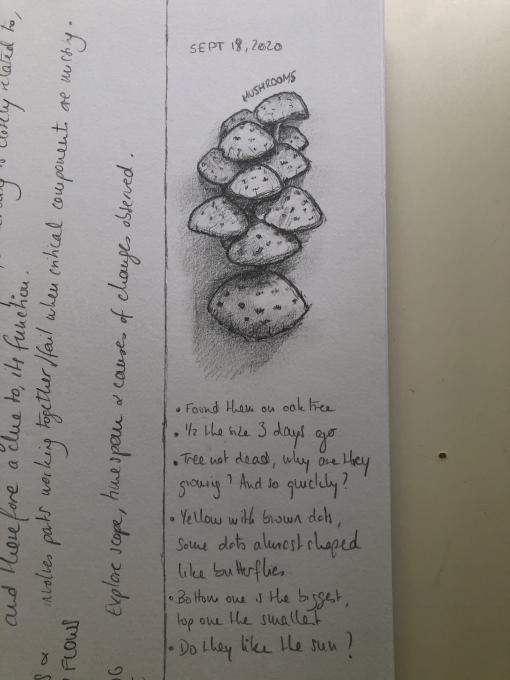 Mushrooms growing in the middle of an oak tree. Themes: Scale & Quantity, Patterns, Changes.
Mushrooms growing in the middle of an oak tree. Themes: Scale & Quantity, Patterns, Changes. 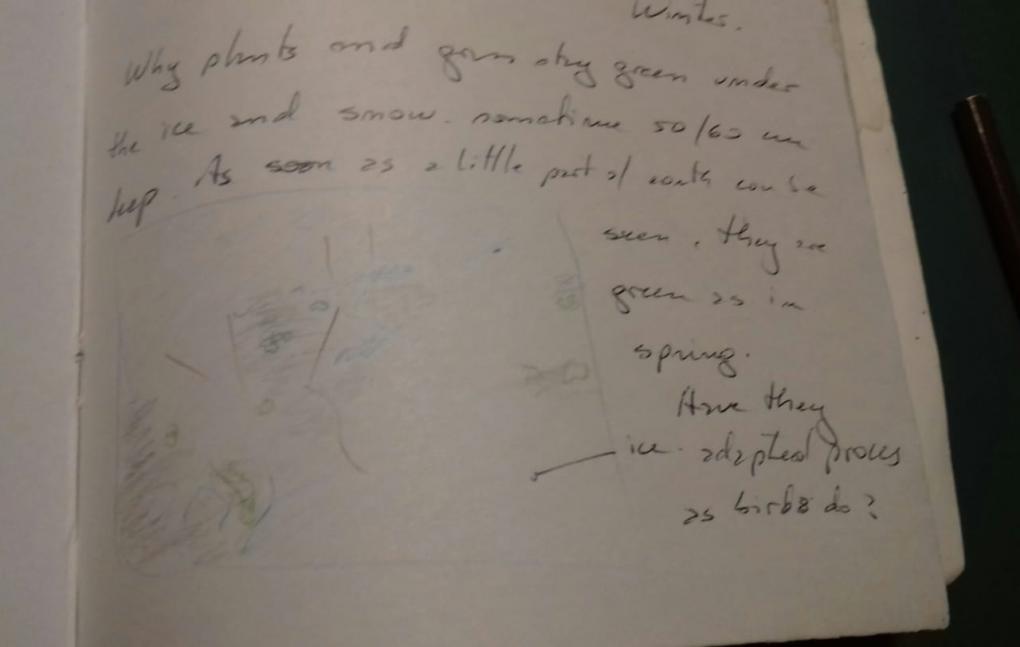 I wander how grass and plants stay green under several centimetres of snow and ice in winter. Perhaps they have some mecanism of adaption, as birds do, but I do not know. I noticed some tiny birds stay here in winter, and their tiny feet in the ice and snow seem not to bother them.
I wander how grass and plants stay green under several centimetres of snow and ice in winter. Perhaps they have some mecanism of adaption, as birds do, but I do not know. I noticed some tiny birds stay here in winter, and their tiny feet in the ice and snow seem not to bother them.
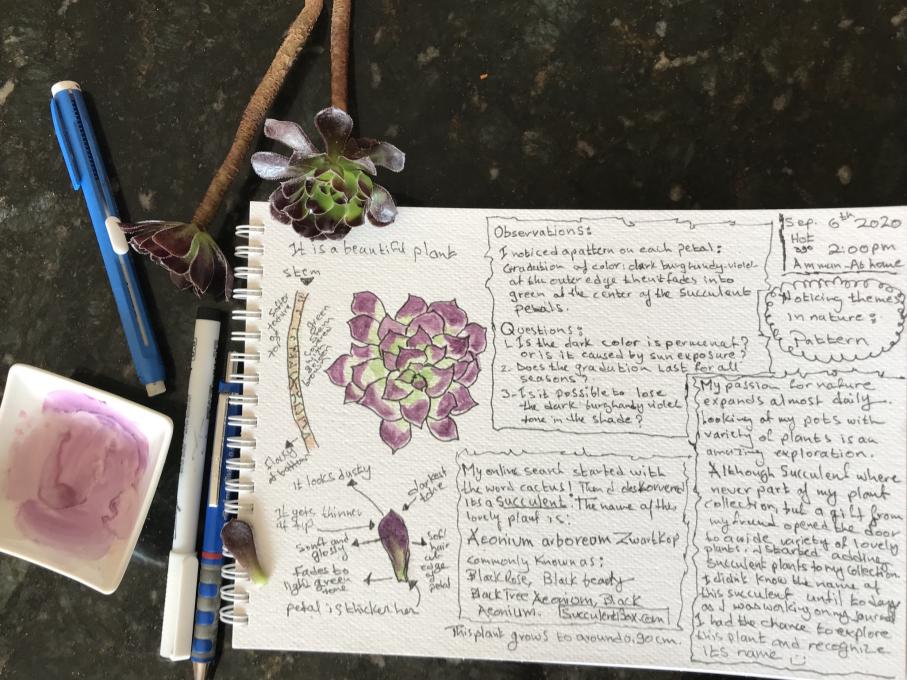
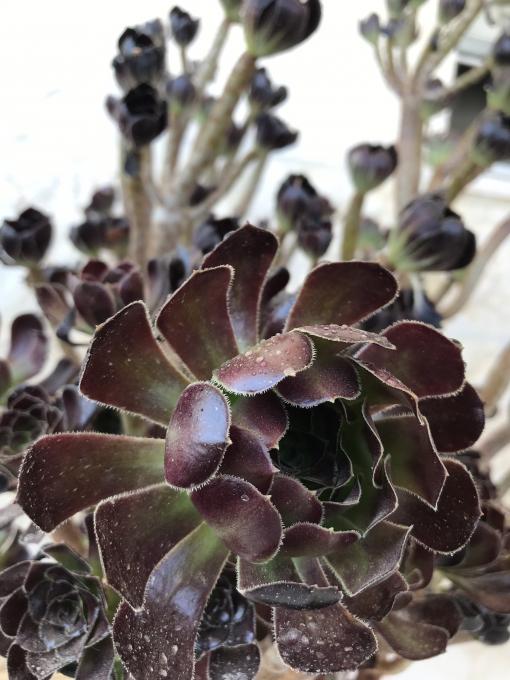
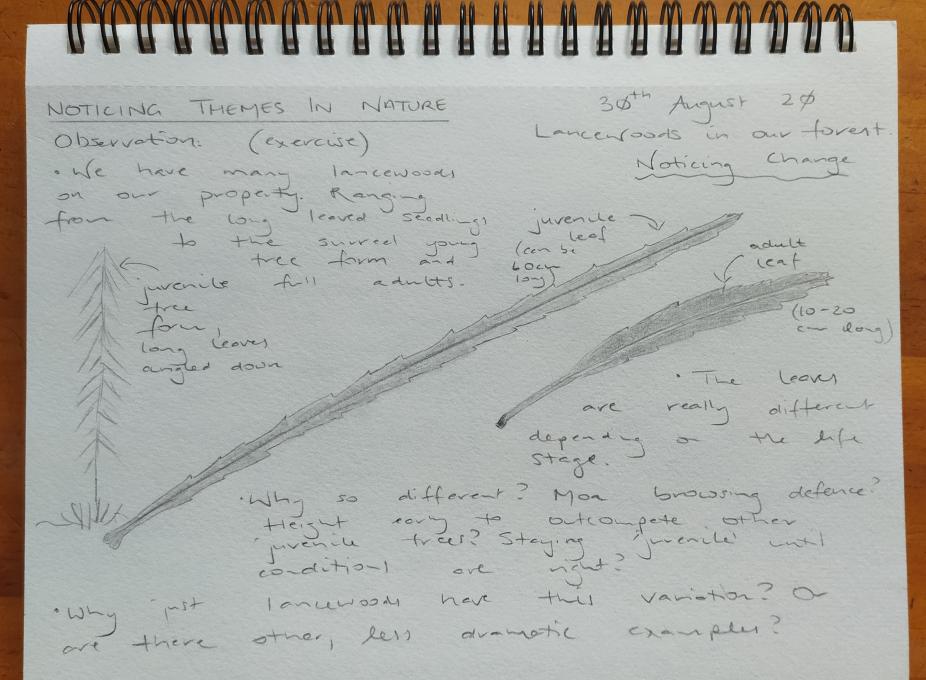
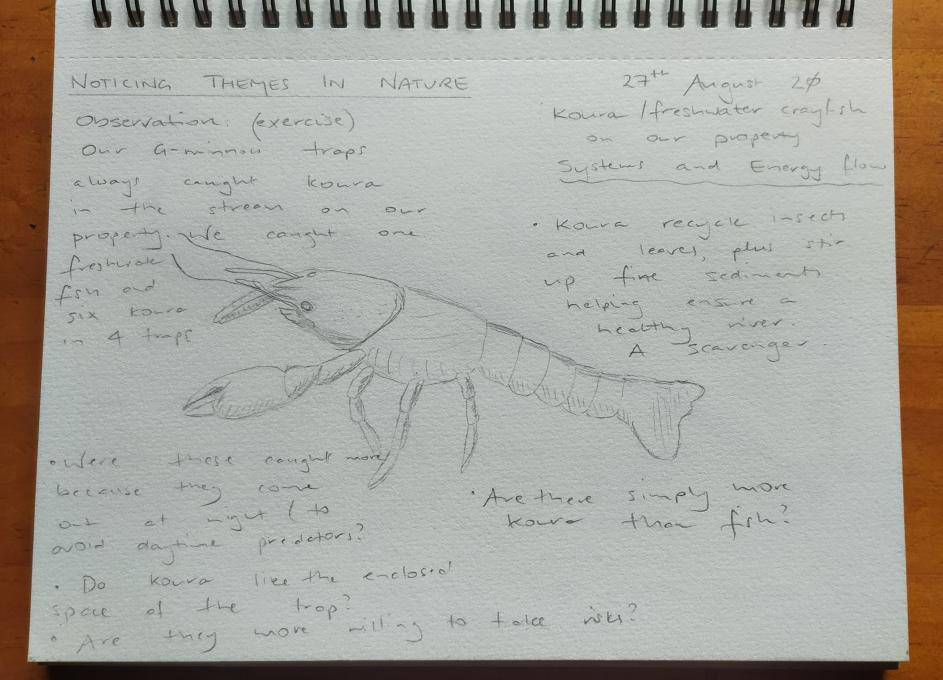
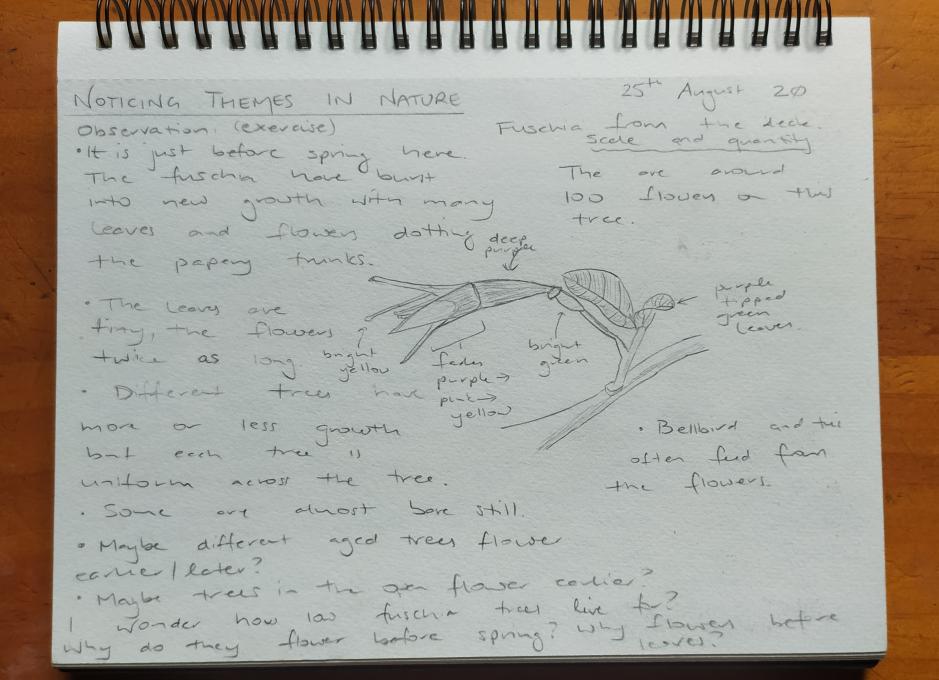
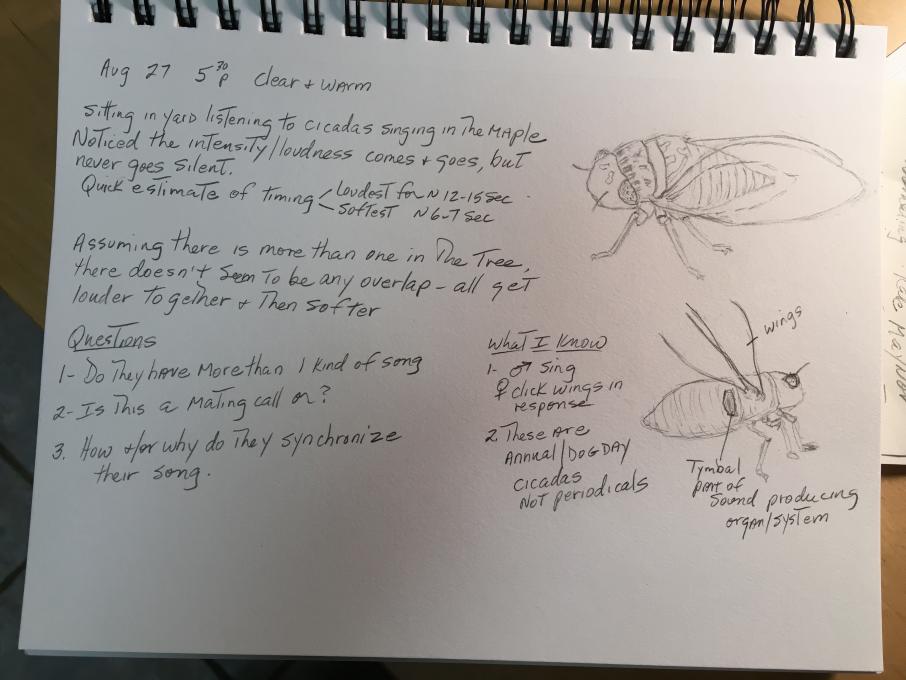
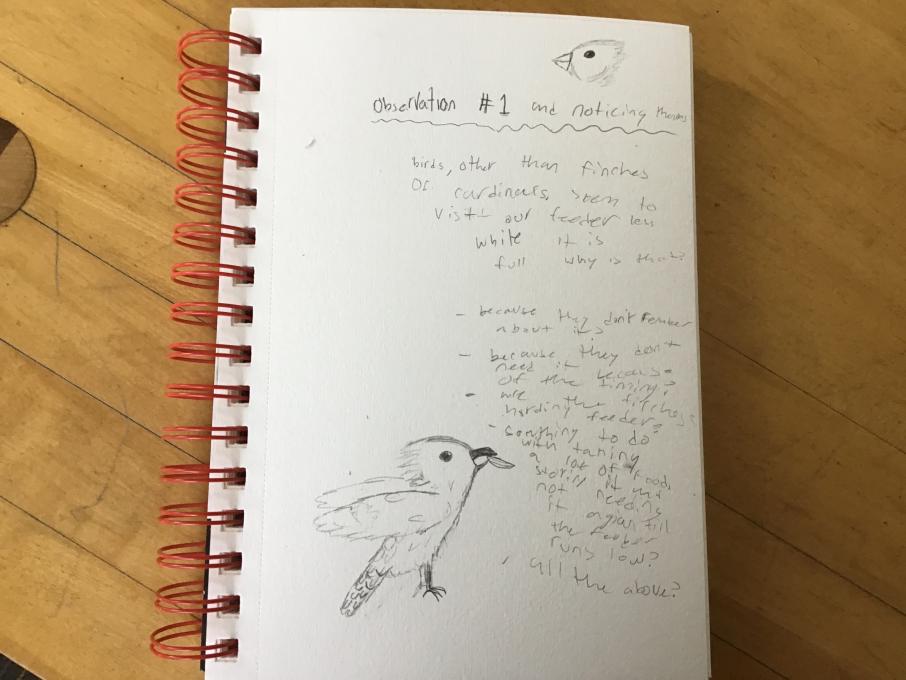
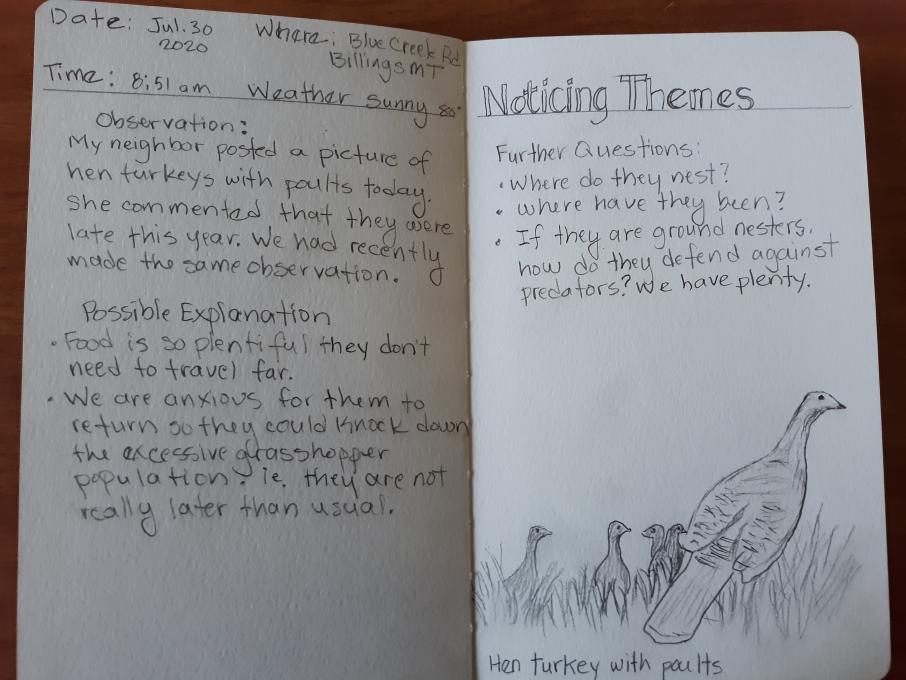
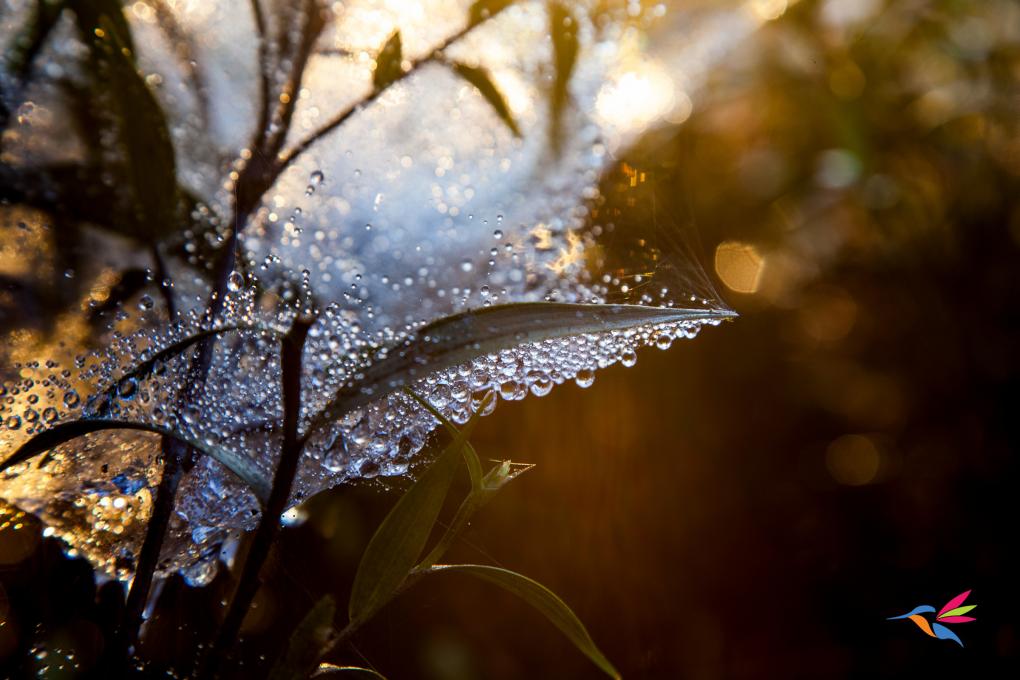
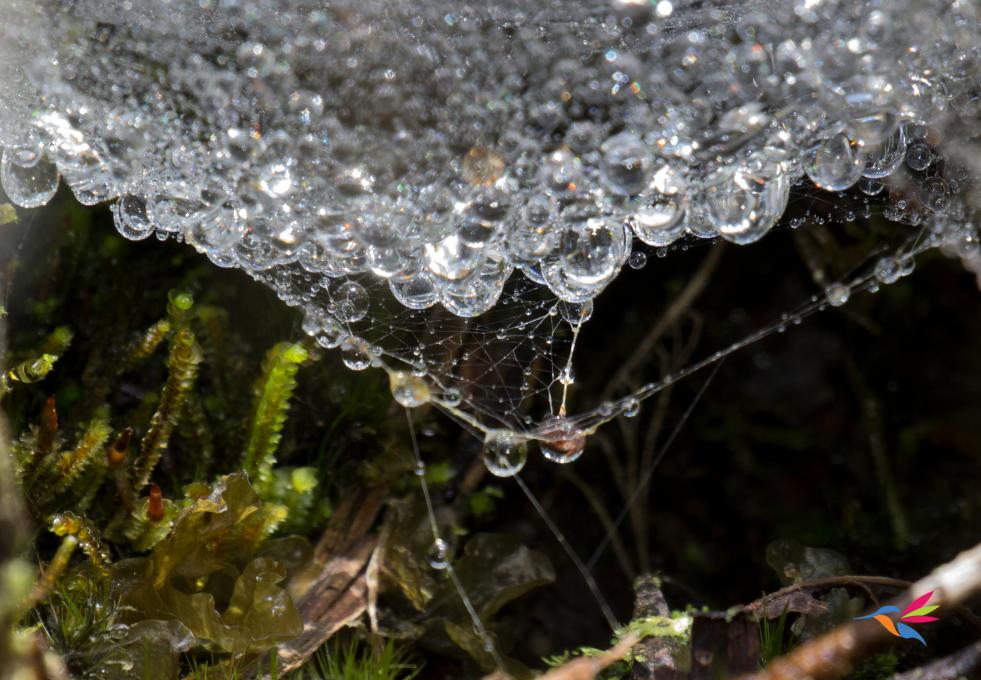
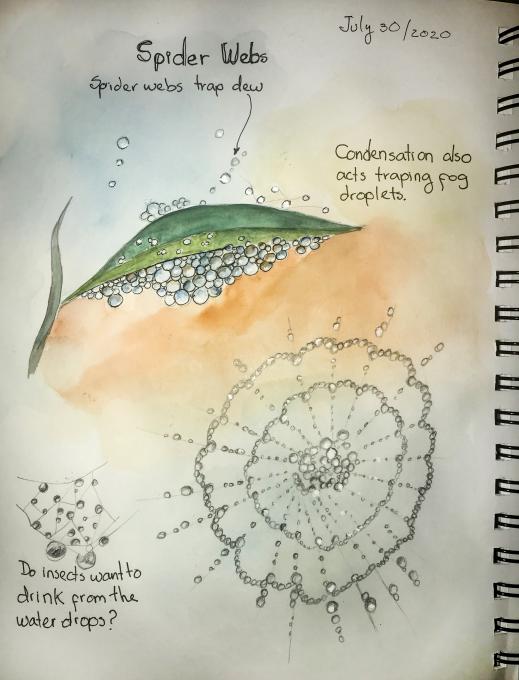
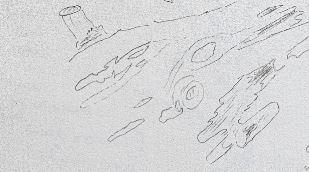 A fallen tree with beautiful patterns and shadows as decomposition starts. Are insects making these patterns or is it just water prompted rotting?
A fallen tree with beautiful patterns and shadows as decomposition starts. Are insects making these patterns or is it just water prompted rotting? 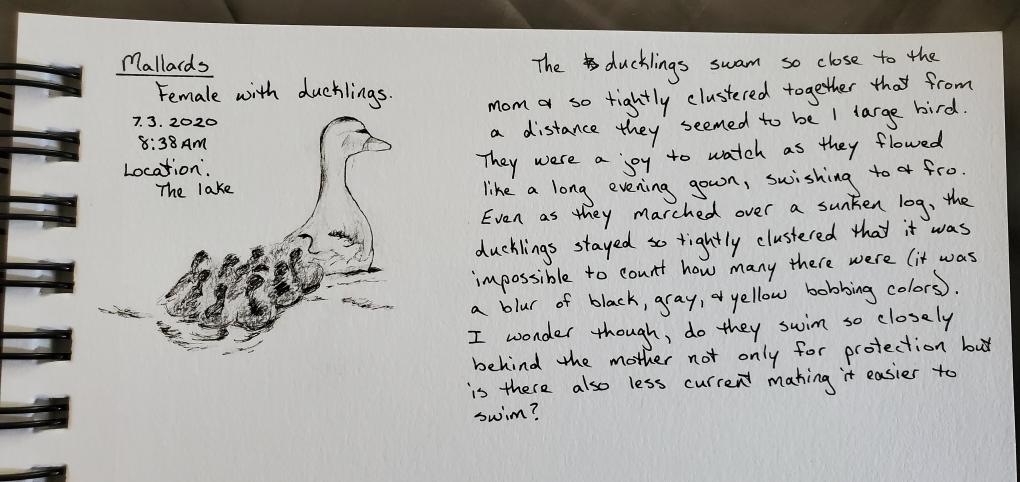
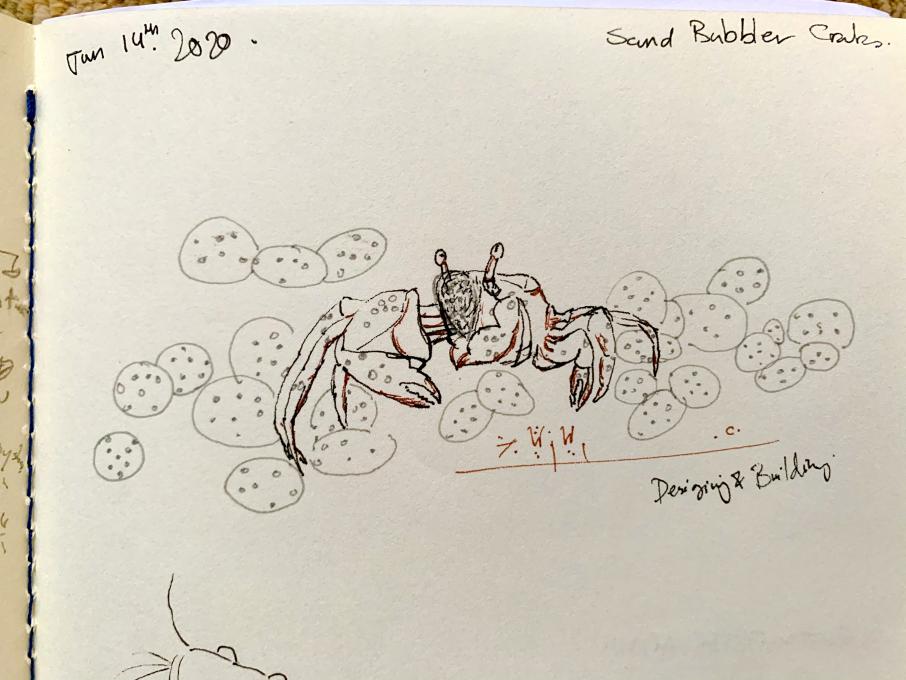 I went to observe the sand crabs - tinny creatures that will disappear with the any movement around it. So, you have to stay still for a bit more than 5 minutes for them to comeback and continue their pieces of art on the sand.
They appear when the tide is low. They are at the lowest level of the ecosystems, shore birds would eat them (I don’t know if the fishes does too but this makes me wonder where do they go when to seawater covers this area of the beach).
The create clean pretty forms in the ground with the beach sand. I was able to video several scenes while they are sucking the sand into their lower body whole then bubbling it out of their mouth creating mini-sand balls. They try to rearrange the sandballs by fixing them in lines with their back legs (Am I using the right word here?).
I went to observe the sand crabs - tinny creatures that will disappear with the any movement around it. So, you have to stay still for a bit more than 5 minutes for them to comeback and continue their pieces of art on the sand.
They appear when the tide is low. They are at the lowest level of the ecosystems, shore birds would eat them (I don’t know if the fishes does too but this makes me wonder where do they go when to seawater covers this area of the beach).
The create clean pretty forms in the ground with the beach sand. I was able to video several scenes while they are sucking the sand into their lower body whole then bubbling it out of their mouth creating mini-sand balls. They try to rearrange the sandballs by fixing them in lines with their back legs (Am I using the right word here?).
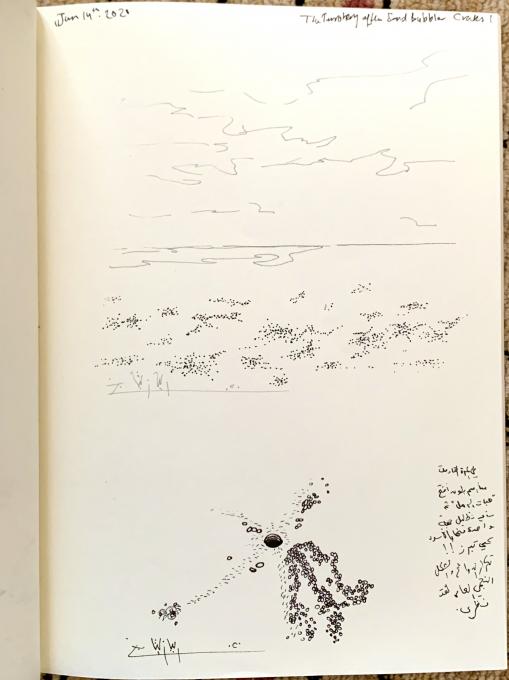 The upper part of the page has a wide scene of the beach; the sand balls looks amazing in reality. The lower part of the page has a close-up of one of the holes , the sand balls, the prints of the sand bubbler crab and the crab (owner of this in process piece of art).
While observing, sketching and videographing, lots of unanswered questions popped into my mind. Some of which are:
1) do they “see” with their eyes or do they sense the vibrations of any movement with their whole body? (They are too fast)
2) why do they form such shapes? Does the bubbled sand-balls has some liquid or smell that comes out of them while bubbling it?
3) is this an indicator of the crab’s territory? Or a mating sign?
4) what is the lifespan of the crab ? At which age(?) do they start designing these bubbled sand ?
5) when the tide is high, and when all their sand-balls are ruins where do they go ? Why do they insist on bubbling new sand-balls over and over and never give up?
6) if they can be pray of birds - doesn’t these sand-balls are clear marks of their existence ? (Bird-view wise they can be spotted easily!)
Guess I have to research it to find answers :)
The upper part of the page has a wide scene of the beach; the sand balls looks amazing in reality. The lower part of the page has a close-up of one of the holes , the sand balls, the prints of the sand bubbler crab and the crab (owner of this in process piece of art).
While observing, sketching and videographing, lots of unanswered questions popped into my mind. Some of which are:
1) do they “see” with their eyes or do they sense the vibrations of any movement with their whole body? (They are too fast)
2) why do they form such shapes? Does the bubbled sand-balls has some liquid or smell that comes out of them while bubbling it?
3) is this an indicator of the crab’s territory? Or a mating sign?
4) what is the lifespan of the crab ? At which age(?) do they start designing these bubbled sand ?
5) when the tide is high, and when all their sand-balls are ruins where do they go ? Why do they insist on bubbling new sand-balls over and over and never give up?
6) if they can be pray of birds - doesn’t these sand-balls are clear marks of their existence ? (Bird-view wise they can be spotted easily!)
Guess I have to research it to find answers :) 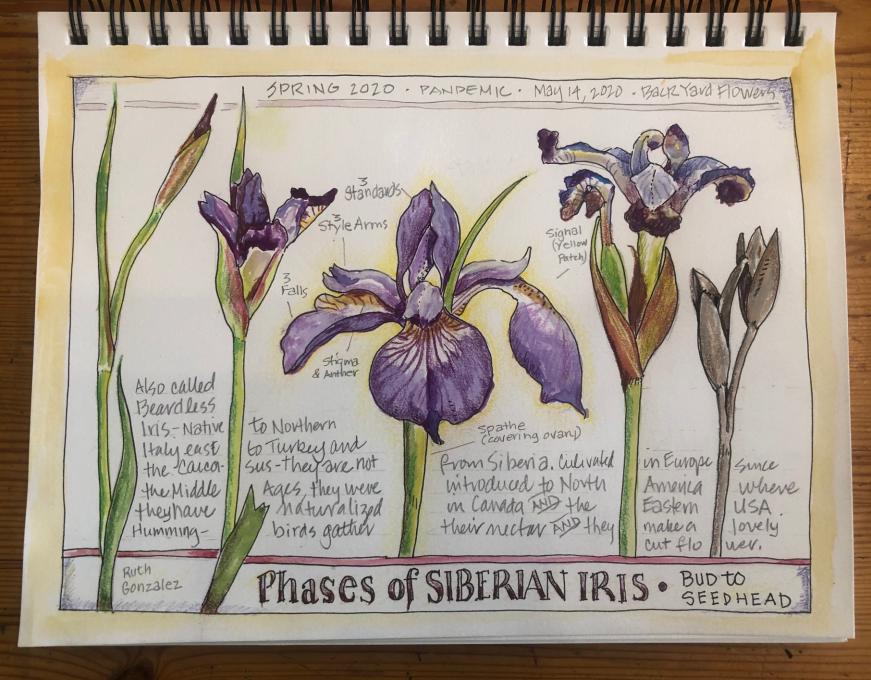 I have a big patch of Siberian Iris in my backyard that is currently showing all phases of its reproductive cycle, and showing the life cycle change the flower is going through including the seedhead that is formed after pollination. The seedheads in my garden are from last year's flowers that were never deadheaded. Siberian Iris reproduce by seed and by their rhizomes spreading. The Anther is hidden under the Style arms and above the Fall (the lower petal). You really have to look for the Anther. I could not find it at first. I imagine that pollinators are enticed in by the Signal (the yellow patch) and the veining which seems to be saying "here I am...come pollinate me". I drew the central flower with a yellow glow to indicate that it is at the height of readiness for reproduction to occur, and doing all it can to communicate that readiness to creatures that can make pollination occur.
I have a big patch of Siberian Iris in my backyard that is currently showing all phases of its reproductive cycle, and showing the life cycle change the flower is going through including the seedhead that is formed after pollination. The seedheads in my garden are from last year's flowers that were never deadheaded. Siberian Iris reproduce by seed and by their rhizomes spreading. The Anther is hidden under the Style arms and above the Fall (the lower petal). You really have to look for the Anther. I could not find it at first. I imagine that pollinators are enticed in by the Signal (the yellow patch) and the veining which seems to be saying "here I am...come pollinate me". I drew the central flower with a yellow glow to indicate that it is at the height of readiness for reproduction to occur, and doing all it can to communicate that readiness to creatures that can make pollination occur.
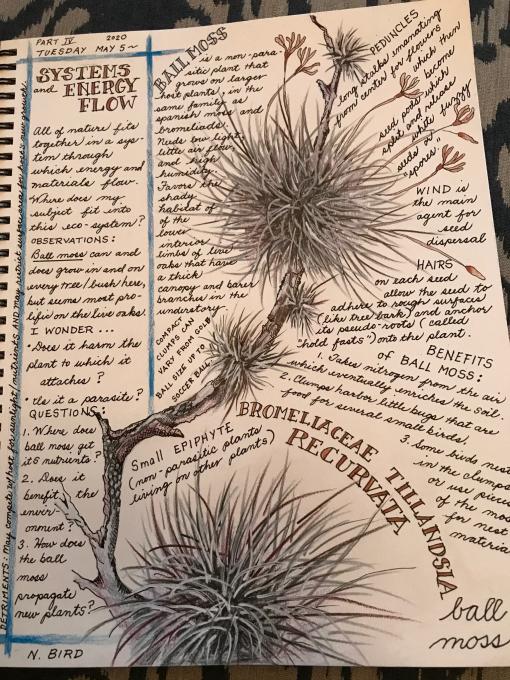
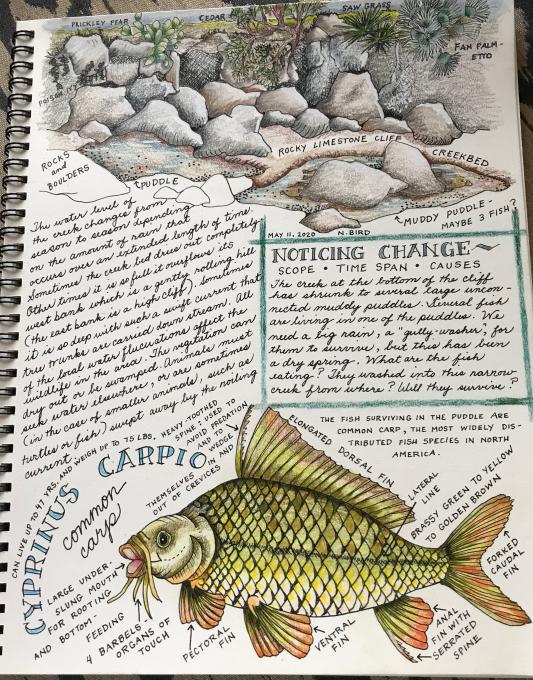
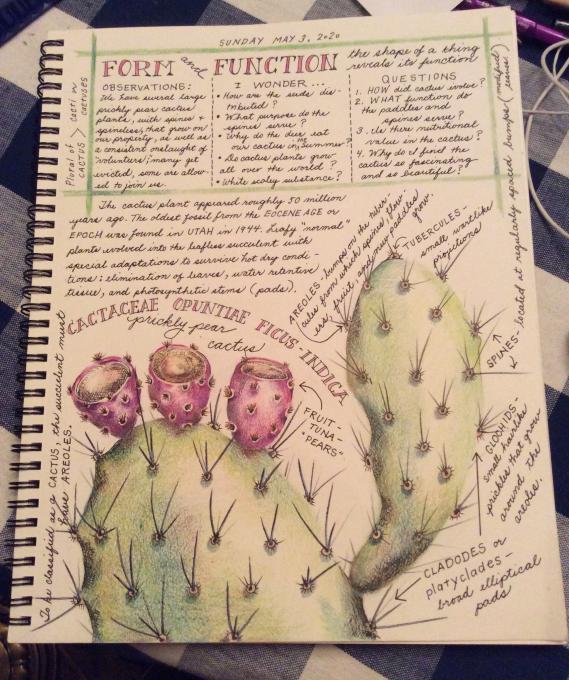
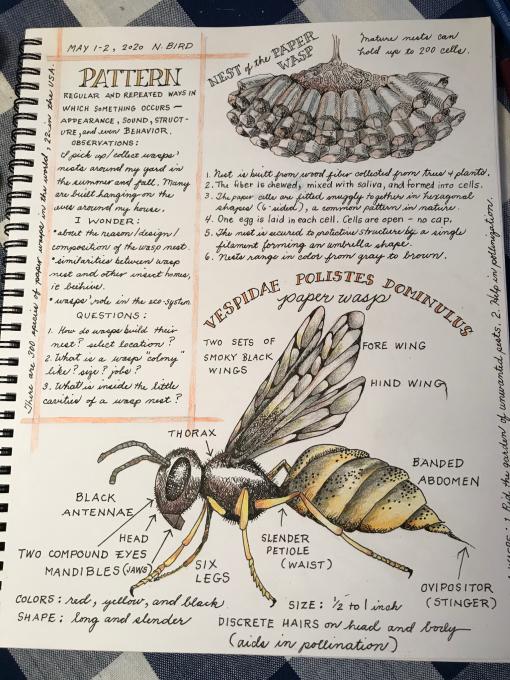
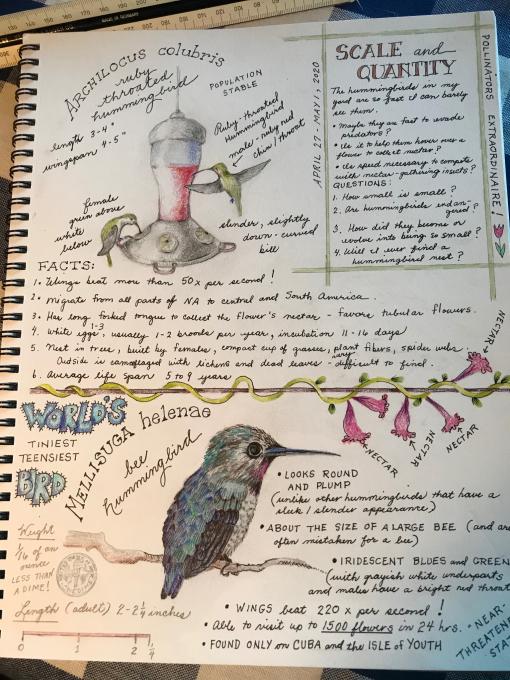
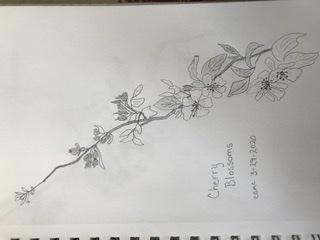
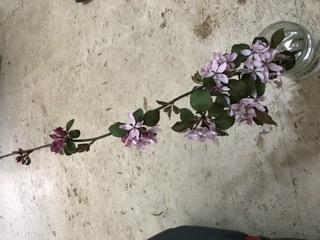
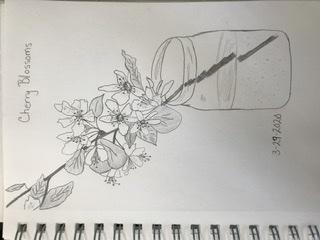 Yes I noticed the scale, quantity, and patterns of the cherry blossoms 🌸 on the branch my husband brought in this past March.
Yes I noticed the scale, quantity, and patterns of the cherry blossoms 🌸 on the branch my husband brought in this past March.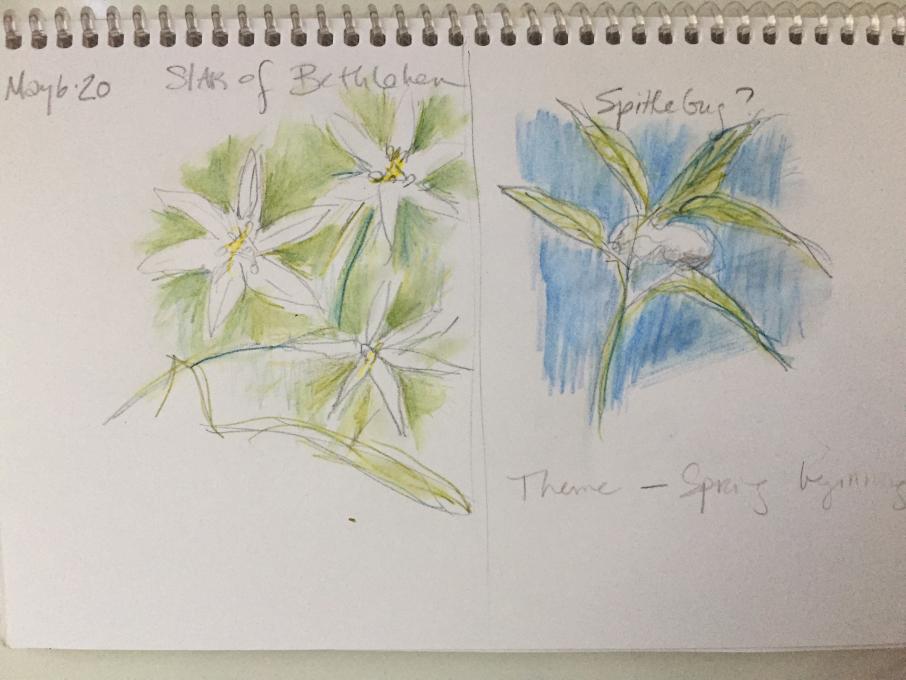
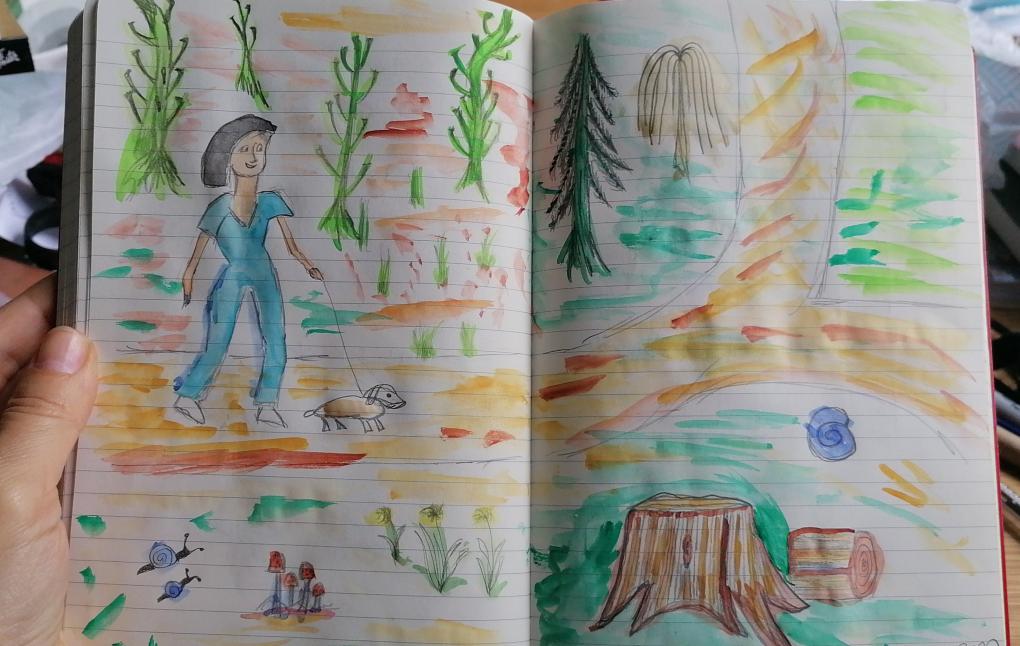
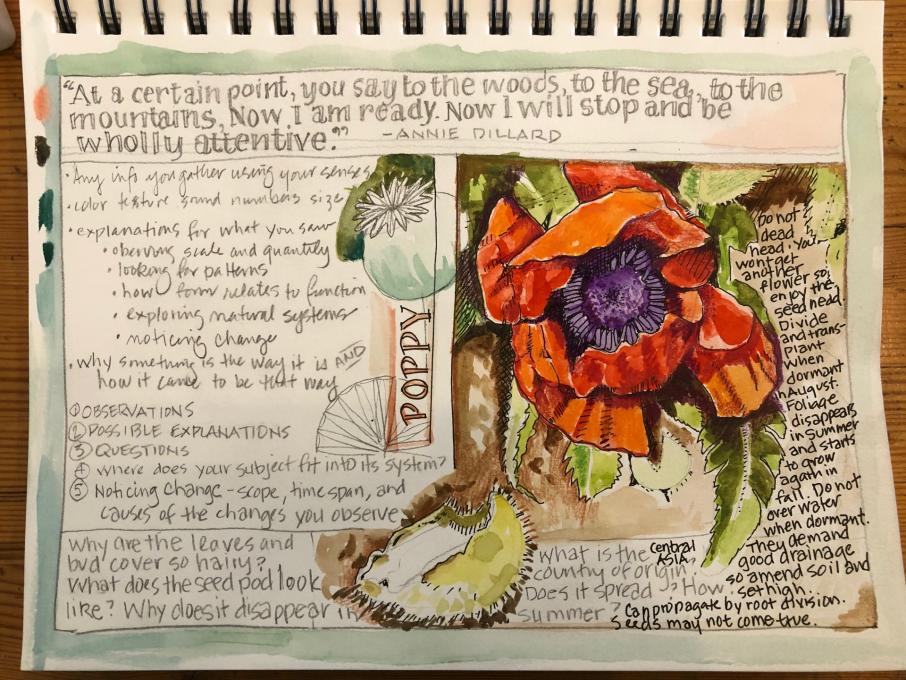 Pattern around flower center *might* become the top of the seedhead. Sawtooth leaves. Flower opened today and hairy bud covering fell to the ground. Different life stages...bud, flower open, later followed by seedhead. Reading about the plant made me decide to dig it up and replant it with more compost so it has better drainage. It is such a dramatic flower.
Pattern around flower center *might* become the top of the seedhead. Sawtooth leaves. Flower opened today and hairy bud covering fell to the ground. Different life stages...bud, flower open, later followed by seedhead. Reading about the plant made me decide to dig it up and replant it with more compost so it has better drainage. It is such a dramatic flower. 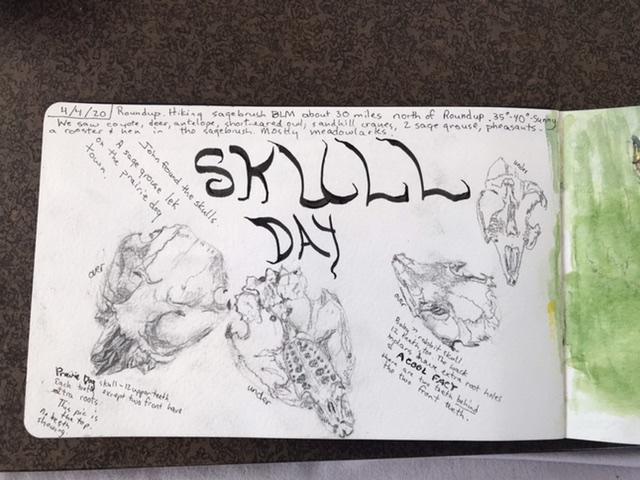
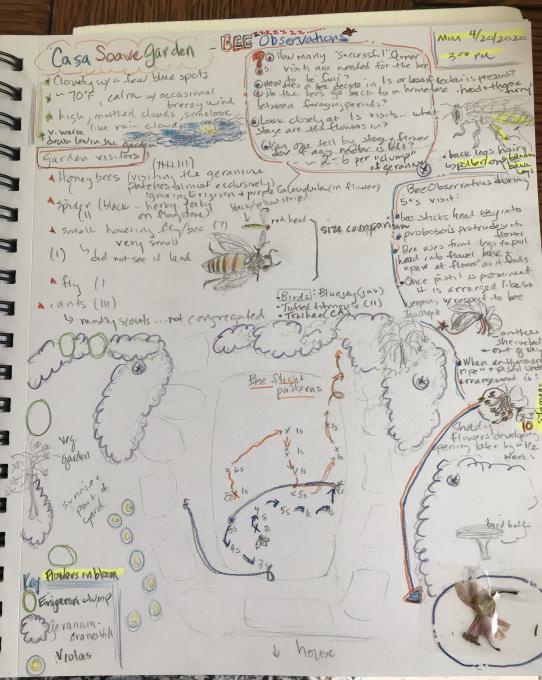 flowers and leaves begin opening up. This observation day led to so many questions (and even a few answers!).
flowers and leaves begin opening up. This observation day led to so many questions (and even a few answers!). 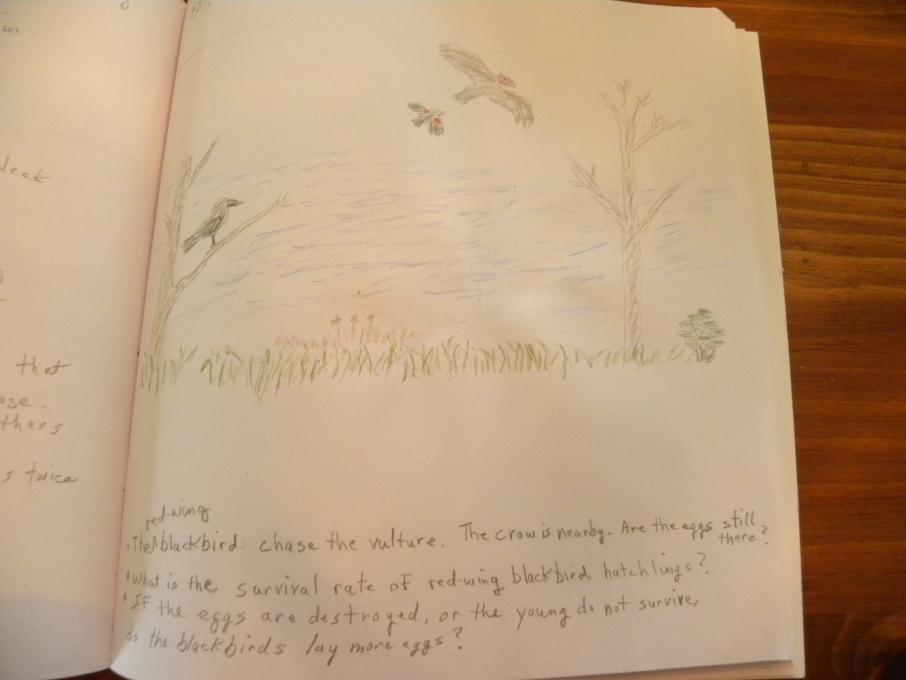
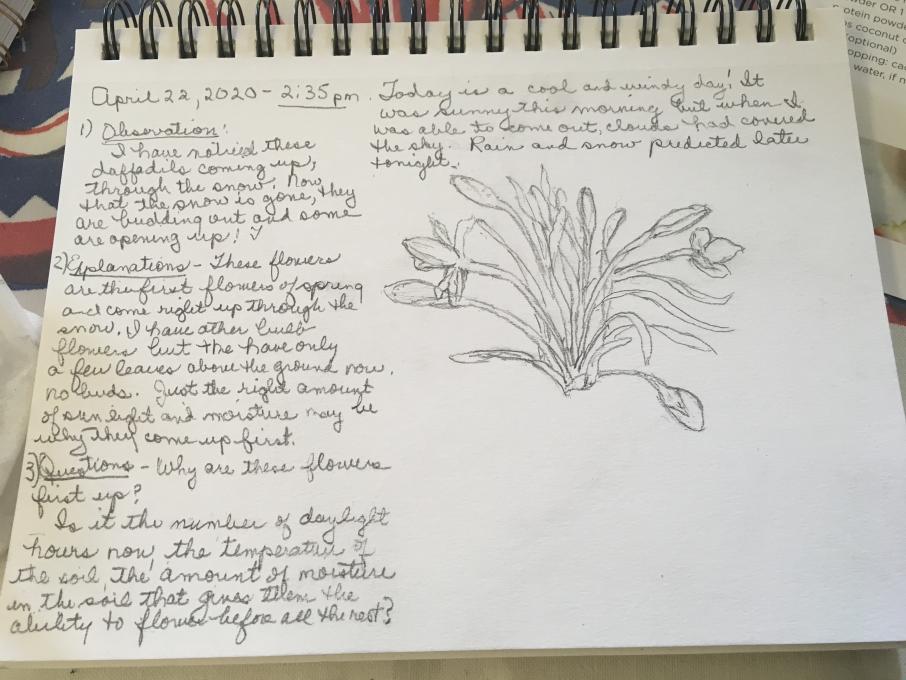 “
“